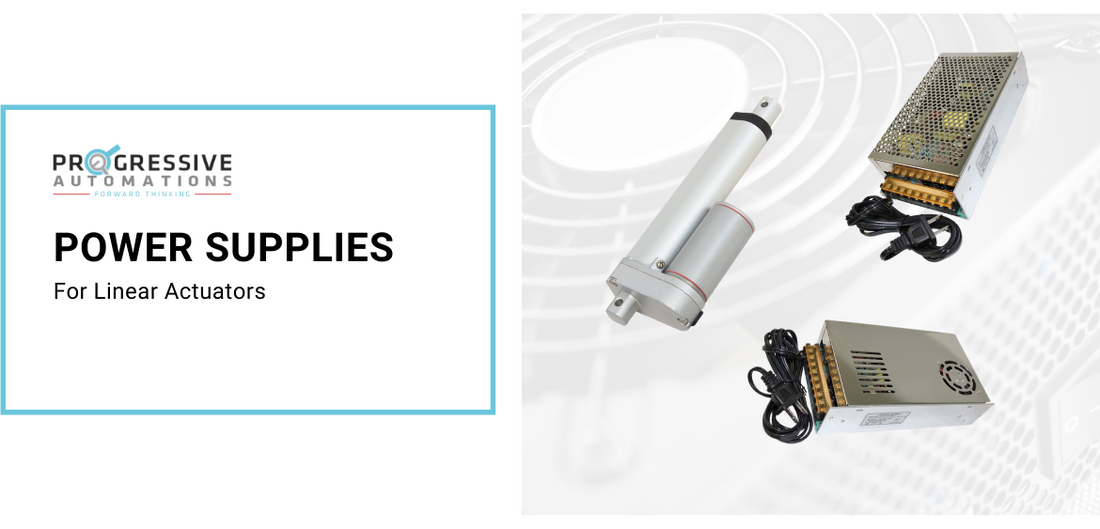It is very important to pick the right power supply for your electric linear actuator. You can have the perfect application design, the best actuator for your need, and a flawless mounting setup, but without choosing the right power supply your system will not function. In this article, we will be going over a few important points on how to choose a power supply for your linear actuator.
Electrical Considerations
Voltage Input
The voltage input of the power supply is dependent on your location, in North America it is 120VAC at 60Hz. Progressive Automations carries a wide range of power supplies that are suitable for most voltage inputs.
For 12V electric actuators, the following types of power supplies are available but not limited to. Full power supply options available can be found here.
- Stationary or portable 12V
- 12-volt 5A AC/DC
- 12-volt 40A AC/DC
The majority of linear actuator motors available in retail have a voltage rating of 12V, there are also 24V models that require voltage converters to be used with the power supplies mentioned above. To understand what kind of power supply for a linear actuator is needed, you will need to reference the technical specifications of the 12-volt linear actuator model. The first thing to note is the maximum rated current, measured in amperes. The rated current needed is equal to the sum of the current requirements for all the linear actuators that will be connected to the power supply.
AC vs. DC Power Supply
The vast majority of electrical appliances today are AC-powered. This is primarily due to the fact that it is easier to convert alternating current from a lower voltage to a higher one and vice versa for transportation over long distances. In the case of direct current, there is the additional complexity associated with voltage regulation. In turn, the ease of AC voltage control allows for adjusting the torque and power of the connected drives.
In practical applications, whether you need an AC or DC power supply depends on how the actuator will be used. If the application is located close to an AC electrical outlet, power can be easily received from there by using an AC power supply. If no AC electrical outlet is available, a DC power supply such as a battery can be used. DC power supplies are mostly used for systems that do not have to work continuously and do not consume a lot of power, as they need to be replaced or recharged after a certain amount of use.
Voltage Output
The voltage output of the power supply chosen needs to match the linear actuator being used. Progressive Automations generally carry 12VDC and 24VDC actuators, but we are also able to custom produce 36VDC and 48VDC electric linear actuators. It is important to match the correct voltage between the actuator and power supply, or it might cause the application to underperform or even damage the electric motor inside the actuator. The voltage requirement information can be found on the label sticker on the linear actuator, this information is also available on our website and datasheet.
5 A Versus 30 A Power Supplies
A 12V converter with a current rating of 5A that converts alternating current into direct current is excellent for systems that do not need to be moved. One would merely need to plug the device into a common power outlet. This will allow the system to work for as long as required without needing periodical recharges. Since the current is quite small, only 5 amperes, such a power supply is usually used to power only one small 12V actuator.
If the system is only using one 12-volt linear actuator, it is better to use a 12-volt DC linear actuator power supply. Such systems consume minimal power, which means they can be portable and are thus not dependent on the location of the outlets. For large stationary systems that require one or more 12-volt linear actuators, a 12V AC power source with an output current of up to 30A is probably needed. These are stationary and plugged into common electric outlets.
Higher current systems need to be carefully configured, and are best left to experienced professionals. There are many aspects that need to be considered such as possible variations to the actuators required current and the maximum current rating of the wires used.
Be mindful of all safety precautions when operating these devices and power supplies. Isolate the device to prevent any access to its live circuits by children or animals, as they can inadvertently suffer serious injuries from the contact with electricity.
Current Rating
The current rating of a power supply is a big factor in choosing the correct unit for an application. The general rule of thumb is that the power supply needs to have a higher current rating than the combined maximum current requirement of all the units connected to the power supply. It is ideal to overshoot the current rating requirement due to the potential extra load the system might experience that is outside of the design. The current drawn on the maximum load is on the Progressive Automations website and each product’s datasheet. We provide power supplies that have a current rating as low as 1 Amp, and as high as 40 Amps.
Physical Considerations
STATIONARY VS PORTABLE BATTERIES
Compact solutions employing a 12-volt DC linear actuator are typically powered by portable batteries. However, the vast majority of systems are stationary, making it better to supply AC power with a system using power transformers directly from the electrical network. Another viable option is energizing the 12V electric linear actuator with stationary batteries through the converter that creates AC out of provided DC power.
IP Rating
The environment of the application can also dictate which power supply to use. If the application allows for an enclosure of the power supply or the power supply is located in a dust-free indoor area, not much consideration needs to be given to the IP rating of the power supply. However, if the power supply will be exposed to the elements, it is needed to select one with a sufficient IP rating. The PS-20-12-67 power supply that Progressive Automation carries has an IP rating of IP67. It is well protected and is designed to use in an outdoor environment.
Waterproof Linear Actuator Power Supplies
In some cases, one may need a waterproof power supply. When choosing one, carefully study the labelling. In particular, check the Ingress Protection (IP) rating which precisely determines the factor of protection against water and dust. The first digit represents the degree of protection against solid objects and dust, and the second indicates how much the device is protected against liquid. For applications close to water, ensure that the power supply can withstand strong water jets or even operate when completely immersed, look for devices with a second digit of five or higher. The best waterproof options for 30A 12V DC actuators are devices with an IP68 protection label. Also, note that insulating elements must withstand voltages above 110V.
Portability and Space
Finally, one must examine how much space is available and if the power supply will need to be moved around a lot. Most power supplies that Progressive Automations carry need a wall outlet. The power supply itself converts the AC voltage to DC voltage to supply to the actuators. This will require some space for the cable to run to the wall outlet, and it is not very portable. If the application is short on space or the power supply needs to move with the application, it would be better to pick up a battery instead. Currently, Progressive Automations carry the AC-03 12VDC 5A battery, it is small in size and has enough current to operate the PA-14, PA-09 and PA-07 linear actuators.
How do you power a 12v linear actuator?
"12v" is better known as "12 VDC" and refers to when direct current is used to power actuators that have a DC motor. For a standard linear actuator, there will be two lead wires that extend from the motor; a positive wire (usually red) and a negative wire (usually black). By using a 12 VDC power supply (a car battery, for example), if you connect the + terminal to the red wire and - terminal to the black wire, the motor will rotate and the stroke rod will extend. If we reversed the polarity and applied - to the red wire and + to the black wire, voltage to the motor will have the motor spin in the opposite direction, making the stroke rod retract. This is the basic function of applying power to a 12 VDC linear actuator, but keep in mind that the amperage will have to be sufficient for the actuator's current draw. You must meet the threshold of the linear actuator's motor, but you typically can't use 'too much' amperage from the power source.
Conclusion
To ensure the successful operation of your application, the correct power supply needs to be installed. Not picking the right power supply could reduce the functionality of your application or it might damage your system. Hopefully, this comprehensive guide will aid your next project. For further questions feel free to contact us at sales@progressiveautomations.com.




